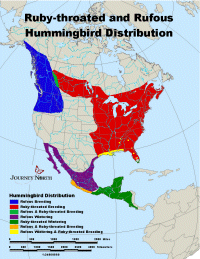Home
on the Wintering Grounds in Costa Rica
We know at least three ruby-throated hummingbirds have reached their winter
home in Costa Rica! Patricia Nethercote announced the news from her backyard
in Guayabo de Bagaces, and she sent snapshots to prove it. The hummingbirds
are pictured here in order of arrival: First came an adult male (October
8th), followed by a juvenile male (October 18th) and finally a female
(October 24th). "The Rubythroats generally arrive at the end of October
and stay until the beginning of March," says Patricia.
- Just think: Maybe one of these hummingbirds visited your feeder during the breeding season or during migration. Thanks for protecting the habitat these hummingbirds needed!
- Notice how little landmass: Look at the range map and you can clearly see, the landmass of the ruby-throated hummingbird's wintering grounds is much smaller than the breeding grounds. The hummingbirds have funneled into a relatively small region for the winter. This is why conservation of winter habitat is especially important. Did you know? Every fall, approximately 350 of the 660 bird species that breed in North America migrate south of the U.S. border for the winter.
Migration
Map: Going, going, and almost gone!
As the animated
migration map shows, hummingbirds are few and far between by the end
of October. Thanks to everyone for reporting the 4,589 observations that
appear on this map. The map shows when and where hummingbirds were present
this fall. Are you still seeing hummingbirds?
Please Report Your Hummingbird Observations!
- Still seeing hummingbirds? Please report regularly if you are still seeing hummingbirds.
- No more hummingbirds? Please submit a FINAL REPORT for your final hummingbird sighting. (Tell us the date you saw your final hummingbird. Do not use today's date or you will be saying that hummingbirds are present today.)
Some Migration Highlights
Here are some observations we gleaned from reading recent reports. You can read all of the observations people have submitted at this link.
- The nature of late fall migration: Single, solo, stragglers, lone, lonely, alone...These are the words people use to describe hummingbird migration in late October.
- Geographic differences: Not a single hummingbird has been reported recently from Canada. Notice which U.S. states are still reporting hummingbirds, and look for regional patterns. (Where do we need more observers? Think about how the lack of observers affects our results.)
- Habitat changes: People are noting ways hummingbird habitat has been changing with the season. What are hummingbirds finding to eat? How are people helping? Look for questions people are asking. ("How long will they stay?" is a common question people are wondering about.)
They're
Home!
Pictured here, in order of their arrival to a backyard
in Costa Rica, are:
An
adult male
Arrived October 8th
A
juvenile male
Arrived October 18th
An
adult female
Arrived October 24th
Little
Landmass on the wintering grounds.
(See
range map.)
| Migration Map (map/sightings/animation) |







